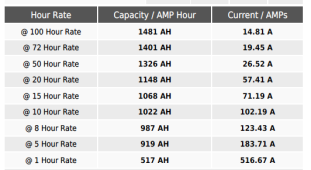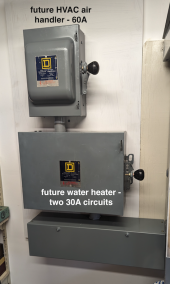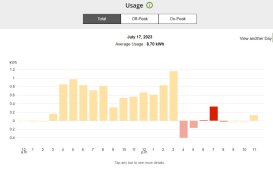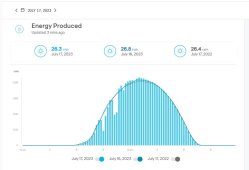Looks like you have a good plan to help the thermostat sense the actual cooling requirements!
When I lived in upstate NY back in the 1970's, I put an incandescent lamp near the thermostat to reduce the
heater operation cycles below what the old "mercury tube" thermostat could sense.
Heating used #2 Diesel - -uggg...
I lived alone in the 1850's farmhouse, did not bother me that the house was 40-50°
I'm going to try an experiment next month with the HVAC here.
Wife is going to be traveling first 2 weeks of August, so I can interrupt house power at will!
Temps here have been in the high 90's day, high 70's night.
There are only a few loads connected to the Schneider inverters now.
I moved things w/ electric motors off grid and on to the inverters, but most of the house is still on grid.
Normally the PV powers the loads shown in the screenshot.

The XW Pro's are configured for "grid support", and use the grid when the PV is not producing enough to support the loads.
The batteries are always in "standby", and only used for the brief transition between PV output "sag", and grid taking over the loads.
When I have the house to myself in August, I'm going to try to run everything off batteries overnight.
Disconnecting the house from the grid.
With the upgraded batteries, it will be possible to source current in the 8-10 hour rate,
until the Sun is up again.

As the HVAC compressor only cycles a few times per hour @ night, I am optimistic.
If this experiment works, next project is to add the HVAC air handler, so that the entire (compressor & air handler) Heat Pump is powered by the inverters.
The problem with this scheme is Winter.
There are usually 10-20 Winter nights here per year that get cold enough that the HVAC activates the 15KW resistive heat coils for a few minutes.
No way I want to subject the inverters to that.
So the plan would be to put the switch in "grid" when the HVAC thermostat is set to " heat", and switch to "solar" when the thermostat is set to "cool".

It might work!!!!
When I lived in upstate NY back in the 1970's, I put an incandescent lamp near the thermostat to reduce the
heater operation cycles below what the old "mercury tube" thermostat could sense.
Heating used #2 Diesel - -uggg...
I lived alone in the 1850's farmhouse, did not bother me that the house was 40-50°
I'm going to try an experiment next month with the HVAC here.
Wife is going to be traveling first 2 weeks of August, so I can interrupt house power at will!
Temps here have been in the high 90's day, high 70's night.
There are only a few loads connected to the Schneider inverters now.
I moved things w/ electric motors off grid and on to the inverters, but most of the house is still on grid.
Normally the PV powers the loads shown in the screenshot.

The XW Pro's are configured for "grid support", and use the grid when the PV is not producing enough to support the loads.
The batteries are always in "standby", and only used for the brief transition between PV output "sag", and grid taking over the loads.
When I have the house to myself in August, I'm going to try to run everything off batteries overnight.
Disconnecting the house from the grid.
With the upgraded batteries, it will be possible to source current in the 8-10 hour rate,
until the Sun is up again.

As the HVAC compressor only cycles a few times per hour @ night, I am optimistic.
If this experiment works, next project is to add the HVAC air handler, so that the entire (compressor & air handler) Heat Pump is powered by the inverters.
The problem with this scheme is Winter.
There are usually 10-20 Winter nights here per year that get cold enough that the HVAC activates the 15KW resistive heat coils for a few minutes.
No way I want to subject the inverters to that.
So the plan would be to put the switch in "grid" when the HVAC thermostat is set to " heat", and switch to "solar" when the thermostat is set to "cool".

It might work!!!!








